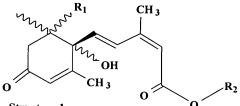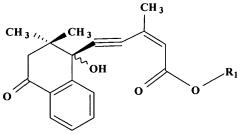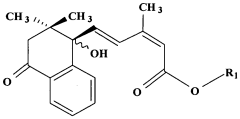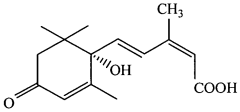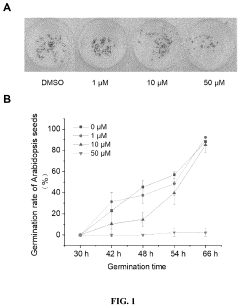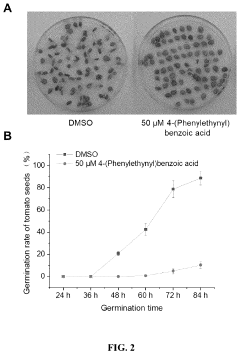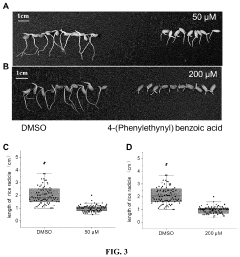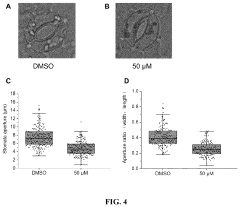Abscisic Acid's Role in Holistic Agricultural Risk Management
JUL 14, 20259 MIN READ
Generate Your Research Report Instantly with AI Agent
Patsnap Eureka helps you evaluate technical feasibility & market potential.
ABA Background and Objectives
Abscisic acid (ABA) is a plant hormone that plays a crucial role in regulating various physiological processes, particularly in response to environmental stresses. Discovered in the 1960s, ABA has since been recognized as a key player in plant stress tolerance and adaptation. Its significance in agricultural risk management has grown exponentially over the past few decades, as climate change and environmental challenges continue to threaten global food security.
The primary objective of exploring ABA's role in holistic agricultural risk management is to develop innovative strategies that enhance crop resilience and productivity under adverse conditions. By understanding the intricate mechanisms through which ABA mediates stress responses, researchers aim to engineer crops with improved tolerance to drought, salinity, extreme temperatures, and other abiotic stresses. This knowledge can be leveraged to create more sustainable and efficient agricultural practices, ultimately contributing to food security in the face of climate change.
ABA's multifaceted functions in plants make it an ideal target for agricultural risk management. It regulates stomatal closure, thereby controlling water loss through transpiration during drought stress. Additionally, ABA influences seed dormancy, germination, and seedling growth, which are critical factors in crop establishment and yield. The hormone also plays a role in root architecture development, enabling plants to optimize water and nutrient uptake under challenging soil conditions.
Recent technological advancements have significantly enhanced our understanding of ABA signaling pathways and their interactions with other plant hormones and environmental factors. Genomic and proteomic approaches have revealed complex regulatory networks that govern ABA-mediated stress responses. This knowledge has paved the way for targeted genetic modifications and breeding programs aimed at developing stress-resistant crop varieties.
The evolution of ABA research has seen a shift from focusing solely on its role in drought tolerance to a more comprehensive approach that considers its impact on overall plant health and productivity. This holistic perspective aligns with the growing recognition of the interconnected nature of agricultural risks, including climate variability, pest pressures, and market fluctuations. By harnessing ABA's potential, researchers and agronomists seek to develop integrated solutions that address multiple risk factors simultaneously.
As we look towards the future, the objectives of ABA research in agricultural risk management are expanding. These include developing ABA-based biostimulants, optimizing irrigation strategies through ABA-mediated physiological responses, and creating predictive models that incorporate ABA signaling data for improved crop management decisions. The ultimate goal is to translate scientific insights into practical applications that can be readily adopted by farmers and agricultural industries worldwide.
The primary objective of exploring ABA's role in holistic agricultural risk management is to develop innovative strategies that enhance crop resilience and productivity under adverse conditions. By understanding the intricate mechanisms through which ABA mediates stress responses, researchers aim to engineer crops with improved tolerance to drought, salinity, extreme temperatures, and other abiotic stresses. This knowledge can be leveraged to create more sustainable and efficient agricultural practices, ultimately contributing to food security in the face of climate change.
ABA's multifaceted functions in plants make it an ideal target for agricultural risk management. It regulates stomatal closure, thereby controlling water loss through transpiration during drought stress. Additionally, ABA influences seed dormancy, germination, and seedling growth, which are critical factors in crop establishment and yield. The hormone also plays a role in root architecture development, enabling plants to optimize water and nutrient uptake under challenging soil conditions.
Recent technological advancements have significantly enhanced our understanding of ABA signaling pathways and their interactions with other plant hormones and environmental factors. Genomic and proteomic approaches have revealed complex regulatory networks that govern ABA-mediated stress responses. This knowledge has paved the way for targeted genetic modifications and breeding programs aimed at developing stress-resistant crop varieties.
The evolution of ABA research has seen a shift from focusing solely on its role in drought tolerance to a more comprehensive approach that considers its impact on overall plant health and productivity. This holistic perspective aligns with the growing recognition of the interconnected nature of agricultural risks, including climate variability, pest pressures, and market fluctuations. By harnessing ABA's potential, researchers and agronomists seek to develop integrated solutions that address multiple risk factors simultaneously.
As we look towards the future, the objectives of ABA research in agricultural risk management are expanding. These include developing ABA-based biostimulants, optimizing irrigation strategies through ABA-mediated physiological responses, and creating predictive models that incorporate ABA signaling data for improved crop management decisions. The ultimate goal is to translate scientific insights into practical applications that can be readily adopted by farmers and agricultural industries worldwide.
Market Demand Analysis
The market demand for Abscisic Acid (ABA) in holistic agricultural risk management is experiencing significant growth, driven by increasing awareness of climate change impacts and the need for sustainable farming practices. As extreme weather events become more frequent and severe, farmers are seeking innovative solutions to mitigate crop losses and enhance resilience. ABA, a plant hormone known for its role in stress response and adaptation, has emerged as a promising tool in this context.
The global agricultural biologicals market, which includes plant growth regulators like ABA, is projected to expand rapidly in the coming years. This growth is fueled by the rising adoption of eco-friendly farming methods and the push for reduced chemical inputs in agriculture. Farmers are increasingly recognizing the potential of ABA-based products to improve crop stress tolerance, water use efficiency, and overall plant health, leading to higher yields and better quality produce.
In developed agricultural markets such as North America and Europe, there is a growing demand for ABA-based solutions as part of integrated crop management strategies. These regions are at the forefront of precision agriculture and are more likely to adopt advanced technologies for risk mitigation. Developing countries, particularly in Asia and Africa, are also showing increased interest in ABA applications as they grapple with food security challenges exacerbated by climate change.
The market for ABA in agricultural risk management is closely tied to the broader trends in sustainable agriculture and climate-smart farming. As governments worldwide implement stricter regulations on chemical pesticides and fertilizers, the demand for biological alternatives like ABA is expected to surge. This regulatory environment, coupled with consumer preferences for organic and sustainably produced food, is creating a favorable market landscape for ABA-based products.
However, the market faces certain challenges that could impact demand. The relatively high cost of ABA production and the need for extensive farmer education on its benefits and proper application techniques are potential barriers to widespread adoption. Additionally, the effectiveness of ABA can vary depending on crop type, environmental conditions, and application timing, which necessitates further research and development to optimize its use across diverse agricultural systems.
Despite these challenges, the long-term market outlook for ABA in agricultural risk management remains positive. As climate change continues to pose significant threats to global food production, the demand for innovative, sustainable solutions like ABA is expected to grow. This presents opportunities for agribiotech companies, research institutions, and agricultural service providers to develop and market ABA-based products and services tailored to the evolving needs of farmers worldwide.
The global agricultural biologicals market, which includes plant growth regulators like ABA, is projected to expand rapidly in the coming years. This growth is fueled by the rising adoption of eco-friendly farming methods and the push for reduced chemical inputs in agriculture. Farmers are increasingly recognizing the potential of ABA-based products to improve crop stress tolerance, water use efficiency, and overall plant health, leading to higher yields and better quality produce.
In developed agricultural markets such as North America and Europe, there is a growing demand for ABA-based solutions as part of integrated crop management strategies. These regions are at the forefront of precision agriculture and are more likely to adopt advanced technologies for risk mitigation. Developing countries, particularly in Asia and Africa, are also showing increased interest in ABA applications as they grapple with food security challenges exacerbated by climate change.
The market for ABA in agricultural risk management is closely tied to the broader trends in sustainable agriculture and climate-smart farming. As governments worldwide implement stricter regulations on chemical pesticides and fertilizers, the demand for biological alternatives like ABA is expected to surge. This regulatory environment, coupled with consumer preferences for organic and sustainably produced food, is creating a favorable market landscape for ABA-based products.
However, the market faces certain challenges that could impact demand. The relatively high cost of ABA production and the need for extensive farmer education on its benefits and proper application techniques are potential barriers to widespread adoption. Additionally, the effectiveness of ABA can vary depending on crop type, environmental conditions, and application timing, which necessitates further research and development to optimize its use across diverse agricultural systems.
Despite these challenges, the long-term market outlook for ABA in agricultural risk management remains positive. As climate change continues to pose significant threats to global food production, the demand for innovative, sustainable solutions like ABA is expected to grow. This presents opportunities for agribiotech companies, research institutions, and agricultural service providers to develop and market ABA-based products and services tailored to the evolving needs of farmers worldwide.
ABA Research Status
Abscisic acid (ABA) research has made significant strides in recent years, particularly in understanding its role in holistic agricultural risk management. The current status of ABA research is characterized by a multifaceted approach, encompassing molecular biology, genetics, physiology, and agronomic applications.
At the molecular level, researchers have made substantial progress in elucidating the ABA signaling pathway. The identification of the PYR/PYL/RCAR family of ABA receptors has been a major breakthrough, providing insights into how plants perceive and respond to environmental stresses. This discovery has led to a more comprehensive understanding of ABA-mediated stress responses, including drought tolerance, salt resistance, and temperature adaptation.
Genetic studies have revealed numerous genes involved in ABA biosynthesis, catabolism, and signaling. The characterization of these genes has enabled the development of crop varieties with enhanced stress tolerance. For instance, overexpression of certain ABA-responsive genes has resulted in plants with improved drought resistance without significant yield penalties.
In the realm of plant physiology, recent research has focused on the intricate interplay between ABA and other plant hormones. This cross-talk is crucial for fine-tuning plant responses to various environmental challenges. Studies have shown that ABA interacts with ethylene, jasmonic acid, and salicylic acid pathways, orchestrating complex responses to biotic and abiotic stresses.
The application of ABA research in agriculture has gained momentum, with a focus on developing sustainable strategies for crop protection. Exogenous ABA application has shown promise in mitigating the effects of drought, salinity, and extreme temperatures. However, the practical implementation of ABA-based treatments in large-scale agriculture remains a challenge due to issues such as cost-effectiveness and application methods.
Emerging technologies, such as CRISPR-Cas9 gene editing, are being employed to manipulate ABA-related genes, offering new possibilities for crop improvement. These techniques allow for precise modifications of ABA biosynthesis and signaling pathways, potentially leading to crops with enhanced stress resilience and improved yield stability under adverse conditions.
The integration of ABA research with other disciplines, such as metabolomics and systems biology, is providing a more holistic view of plant stress responses. This interdisciplinary approach is crucial for developing comprehensive agricultural risk management strategies that consider the complex interactions between plants, their environment, and management practices.
Despite these advancements, several challenges remain in ABA research. The translation of laboratory findings to field conditions is often problematic due to the complexity of environmental factors. Additionally, the long-term effects of manipulating ABA pathways on plant fitness and ecosystem dynamics require further investigation.
At the molecular level, researchers have made substantial progress in elucidating the ABA signaling pathway. The identification of the PYR/PYL/RCAR family of ABA receptors has been a major breakthrough, providing insights into how plants perceive and respond to environmental stresses. This discovery has led to a more comprehensive understanding of ABA-mediated stress responses, including drought tolerance, salt resistance, and temperature adaptation.
Genetic studies have revealed numerous genes involved in ABA biosynthesis, catabolism, and signaling. The characterization of these genes has enabled the development of crop varieties with enhanced stress tolerance. For instance, overexpression of certain ABA-responsive genes has resulted in plants with improved drought resistance without significant yield penalties.
In the realm of plant physiology, recent research has focused on the intricate interplay between ABA and other plant hormones. This cross-talk is crucial for fine-tuning plant responses to various environmental challenges. Studies have shown that ABA interacts with ethylene, jasmonic acid, and salicylic acid pathways, orchestrating complex responses to biotic and abiotic stresses.
The application of ABA research in agriculture has gained momentum, with a focus on developing sustainable strategies for crop protection. Exogenous ABA application has shown promise in mitigating the effects of drought, salinity, and extreme temperatures. However, the practical implementation of ABA-based treatments in large-scale agriculture remains a challenge due to issues such as cost-effectiveness and application methods.
Emerging technologies, such as CRISPR-Cas9 gene editing, are being employed to manipulate ABA-related genes, offering new possibilities for crop improvement. These techniques allow for precise modifications of ABA biosynthesis and signaling pathways, potentially leading to crops with enhanced stress resilience and improved yield stability under adverse conditions.
The integration of ABA research with other disciplines, such as metabolomics and systems biology, is providing a more holistic view of plant stress responses. This interdisciplinary approach is crucial for developing comprehensive agricultural risk management strategies that consider the complex interactions between plants, their environment, and management practices.
Despite these advancements, several challenges remain in ABA research. The translation of laboratory findings to field conditions is often problematic due to the complexity of environmental factors. Additionally, the long-term effects of manipulating ABA pathways on plant fitness and ecosystem dynamics require further investigation.
Current ABA Applications
01 Synthesis and production of abscisic acid
Various methods for synthesizing and producing abscisic acid, including chemical synthesis, biotechnological approaches, and extraction from plant sources. These techniques aim to improve the efficiency and yield of abscisic acid production for agricultural and research applications.- Synthesis and production of abscisic acid: Methods for synthesizing and producing abscisic acid, including chemical synthesis routes and biotechnological approaches using microorganisms or plant cell cultures. These techniques aim to improve the efficiency and yield of abscisic acid production for various applications.
- Agricultural applications of abscisic acid: Use of abscisic acid in agriculture for various purposes, such as regulating plant growth, improving stress tolerance, and enhancing crop yield. Applications include seed treatment, foliar sprays, and soil amendments to modulate plant responses to environmental conditions.
- Abscisic acid analogs and derivatives: Development and use of abscisic acid analogs and derivatives with enhanced stability, bioactivity, or specificity. These compounds may offer improved performance in various applications or provide new functionalities compared to natural abscisic acid.
- Formulations containing abscisic acid: Preparation of various formulations containing abscisic acid for specific applications, including controlled release systems, stabilized compositions, and combinations with other active ingredients. These formulations aim to enhance the efficacy and stability of abscisic acid in different use scenarios.
- Detection and quantification methods for abscisic acid: Development of analytical techniques for detecting and quantifying abscisic acid in various biological samples. These methods may include immunoassays, chromatographic techniques, or biosensors to measure abscisic acid levels in plants, seeds, or other materials.
02 Agricultural applications of abscisic acid
Use of abscisic acid in agriculture for various purposes, such as improving plant stress tolerance, regulating plant growth and development, enhancing crop yield, and controlling seed dormancy. Applications include foliar sprays, seed treatments, and soil amendments.Expand Specific Solutions03 Abscisic acid analogs and derivatives
Development and use of abscisic acid analogs and derivatives with enhanced stability, bioactivity, or specificity. These compounds may offer improved performance in agricultural applications or serve as research tools for studying abscisic acid-related processes in plants.Expand Specific Solutions04 Abscisic acid signaling and molecular mechanisms
Research into the molecular mechanisms of abscisic acid signaling in plants, including receptor identification, signal transduction pathways, and gene expression regulation. This knowledge contributes to understanding plant responses to environmental stresses and hormone-mediated developmental processes.Expand Specific Solutions05 Formulations and delivery systems for abscisic acid
Development of various formulations and delivery systems for abscisic acid, including microencapsulation, nanoparticles, and controlled-release technologies. These approaches aim to improve the stability, efficacy, and targeted delivery of abscisic acid in agricultural and research applications.Expand Specific Solutions
Key Industry Players
The competitive landscape for Abscisic Acid's role in holistic agricultural risk management is in a growth phase, with increasing market size and technological advancements. The industry is characterized by a mix of established agrochemical companies, academic institutions, and emerging biotech firms. Key players like Valent BioSciences, Syngenta, and Sumitomo Chemical are driving innovation, while research institutions such as China Agricultural University and The Rockefeller University contribute to scientific breakthroughs. The technology's maturity is advancing, with companies like Lomon Bio Technology commercializing S-Abscisic Acid products. This diverse ecosystem suggests a dynamic market with potential for further expansion and technological refinement in agricultural risk management solutions.
Valent BioSciences Corp.
Technical Solution: Valent BioSciences has pioneered the commercial production and application of S-ABA (S-Abscisic Acid) for agricultural risk management. Their proprietary fermentation-based production method ensures a stable supply of high-quality S-ABA[5]. They have developed formulations for foliar application that enhance crop resilience to abiotic stresses such as drought and heat[6]. Valent's research extends to using S-ABA for improving fruit quality and reducing physiological disorders in various crops[7]. Their holistic approach includes integrating S-ABA treatments with precision agriculture techniques to optimize resource use and mitigate climate-related risks[8].
Strengths: Leader in commercial S-ABA production, extensive field trial data, and established distribution networks. Weaknesses: Reliance on a single compound (S-ABA) and potential competition from synthetic analogs.
The Regents of the University of California
Technical Solution: The University of California has conducted groundbreaking research on ABA's role in plant stress responses and its potential for agricultural risk management. Their studies have elucidated the ABA signaling pathway and identified key regulatory components[9]. UC researchers have developed transgenic plants with enhanced ABA sensitivity, demonstrating improved drought tolerance and water use efficiency[10]. They have also explored the interaction between ABA and other phytohormones in stress responses, providing insights for holistic crop management strategies[11]. Recent work has focused on developing ABA-based biosensors for early stress detection in field conditions[12].
Strengths: Cutting-edge basic research, multidisciplinary approach, and strong collaborations with industry. Weaknesses: Potential challenges in translating academic research into practical field applications.
ABA Innovations Review
Liquid compositions containing s-(+)-abscisic acid in combination with selected lipophilic agents and methods of their preparation
PatentWO2008094588A1
Innovation
- The development of liquid compositions containing S-(+)-abscisic acid in combination with selected lipophilic surface active agents, such as ethoxylated amines, which enhance solubility and stability, allowing for higher concentration formulations that can be diluted without precipitation, and include antimicrobial agents for stability.
Use of 4-(phenylethynyl) benzoic acid
PatentActiveUS11992010B2
Innovation
- The use of 4-(Phenylethynyl) benzoic acid as a plant growth regulator, which has a molecular formula of C15H10O2 and a structure suitable for inhibiting seed germination, blocking radicle elongation, and promoting stomata closure, with concentrations ranging from 10 μM to 200 μM, potentially combined with a pesticidally acceptable carrier.
Environmental Impact Assessment
The environmental impact assessment of abscisic acid (ABA) in holistic agricultural risk management reveals both positive and negative effects on ecosystems and biodiversity. ABA, as a plant hormone, plays a crucial role in regulating plant responses to various environmental stresses, including drought, salinity, and extreme temperatures.
One of the primary positive impacts of ABA use in agriculture is its potential to reduce water consumption. By enhancing plants' drought tolerance, ABA can help farmers maintain crop yields while using less water for irrigation. This conservation of water resources is particularly significant in regions facing water scarcity and can contribute to more sustainable agricultural practices.
Additionally, ABA's role in improving plant resilience to abiotic stresses may lead to reduced reliance on chemical pesticides and fertilizers. As plants become more capable of withstanding environmental challenges, farmers may be able to decrease their use of synthetic inputs, potentially reducing soil and water pollution associated with conventional farming methods.
However, the widespread application of ABA in agriculture also raises concerns about potential negative environmental impacts. The introduction of exogenous ABA into ecosystems may disrupt natural plant hormone balances, potentially affecting non-target plant species and altering local biodiversity. This could lead to unintended consequences in plant communities and the organisms that depend on them.
Furthermore, the long-term effects of ABA accumulation in soil and water systems are not yet fully understood. There is a need for comprehensive studies to assess the persistence of ABA in the environment and its potential impacts on soil microorganisms, aquatic ecosystems, and food chains.
The use of ABA in agriculture may also influence pollinator behavior and populations. As ABA affects flower development and nectar production, it could potentially alter plant-pollinator interactions, with cascading effects on ecosystem services and agricultural productivity.
To mitigate potential negative impacts, it is crucial to develop and implement best practices for ABA application in agriculture. This includes optimizing dosage, timing, and application methods to maximize benefits while minimizing environmental risks. Additionally, ongoing monitoring and research are essential to detect and address any unforeseen ecological consequences of ABA use in holistic agricultural risk management.
In conclusion, while ABA offers promising solutions for enhancing agricultural resilience and sustainability, its environmental impacts must be carefully considered and managed. Balancing the benefits of improved crop performance with the potential risks to ecosystems will be key to ensuring the responsible integration of ABA into holistic agricultural risk management strategies.
One of the primary positive impacts of ABA use in agriculture is its potential to reduce water consumption. By enhancing plants' drought tolerance, ABA can help farmers maintain crop yields while using less water for irrigation. This conservation of water resources is particularly significant in regions facing water scarcity and can contribute to more sustainable agricultural practices.
Additionally, ABA's role in improving plant resilience to abiotic stresses may lead to reduced reliance on chemical pesticides and fertilizers. As plants become more capable of withstanding environmental challenges, farmers may be able to decrease their use of synthetic inputs, potentially reducing soil and water pollution associated with conventional farming methods.
However, the widespread application of ABA in agriculture also raises concerns about potential negative environmental impacts. The introduction of exogenous ABA into ecosystems may disrupt natural plant hormone balances, potentially affecting non-target plant species and altering local biodiversity. This could lead to unintended consequences in plant communities and the organisms that depend on them.
Furthermore, the long-term effects of ABA accumulation in soil and water systems are not yet fully understood. There is a need for comprehensive studies to assess the persistence of ABA in the environment and its potential impacts on soil microorganisms, aquatic ecosystems, and food chains.
The use of ABA in agriculture may also influence pollinator behavior and populations. As ABA affects flower development and nectar production, it could potentially alter plant-pollinator interactions, with cascading effects on ecosystem services and agricultural productivity.
To mitigate potential negative impacts, it is crucial to develop and implement best practices for ABA application in agriculture. This includes optimizing dosage, timing, and application methods to maximize benefits while minimizing environmental risks. Additionally, ongoing monitoring and research are essential to detect and address any unforeseen ecological consequences of ABA use in holistic agricultural risk management.
In conclusion, while ABA offers promising solutions for enhancing agricultural resilience and sustainability, its environmental impacts must be carefully considered and managed. Balancing the benefits of improved crop performance with the potential risks to ecosystems will be key to ensuring the responsible integration of ABA into holistic agricultural risk management strategies.
Regulatory Framework for ABA Use
The regulatory framework for Abscisic Acid (ABA) use in agriculture is a complex and evolving landscape that reflects the growing recognition of ABA's potential in holistic agricultural risk management. At the international level, organizations such as the Food and Agriculture Organization (FAO) and the World Health Organization (WHO) play crucial roles in establishing guidelines for the use of plant growth regulators, including ABA. These guidelines often form the basis for national regulations and standards.
In the United States, the Environmental Protection Agency (EPA) is the primary regulatory body overseeing the use of ABA in agriculture. The EPA regulates ABA under the Federal Insecticide, Fungicide, and Rodenticide Act (FIFRA), which requires extensive testing and registration processes before a substance can be approved for agricultural use. The EPA's assessment includes evaluations of environmental impact, human health risks, and efficacy in crop protection and yield enhancement.
The European Union (EU) has a more stringent regulatory approach, governed by the European Food Safety Authority (EFSA). The EU's regulatory framework for plant protection products, including ABA, is outlined in Regulation (EC) No 1107/2009. This regulation emphasizes the precautionary principle and requires thorough risk assessments before approval. The EU also maintains a positive list of approved active substances, which ABA must be included in before it can be used in member states.
In Asia, countries like Japan and China have their own regulatory bodies and frameworks for ABA use. The Japanese Ministry of Agriculture, Forestry and Fisheries (MAFF) oversees the registration and use of plant growth regulators, while in China, the Institute for the Control of Agrochemicals, Ministry of Agriculture (ICAMA) is responsible for regulating ABA and similar substances.
Regulatory frameworks also address the application methods and dosages of ABA. Many countries require specific labeling and application guidelines to ensure proper use and minimize potential environmental impacts. These regulations often include restrictions on the timing of application, maximum residue levels in harvested crops, and buffer zones near water bodies or sensitive ecosystems.
As research continues to unveil new applications of ABA in agricultural risk management, regulatory frameworks are adapting to accommodate these developments. There is a growing trend towards harmonizing regulations across different regions to facilitate international trade and ensure consistent safety standards. However, challenges remain in balancing the potential benefits of ABA use with environmental and health concerns, particularly in the context of climate change and increasing agricultural pressures.
In the United States, the Environmental Protection Agency (EPA) is the primary regulatory body overseeing the use of ABA in agriculture. The EPA regulates ABA under the Federal Insecticide, Fungicide, and Rodenticide Act (FIFRA), which requires extensive testing and registration processes before a substance can be approved for agricultural use. The EPA's assessment includes evaluations of environmental impact, human health risks, and efficacy in crop protection and yield enhancement.
The European Union (EU) has a more stringent regulatory approach, governed by the European Food Safety Authority (EFSA). The EU's regulatory framework for plant protection products, including ABA, is outlined in Regulation (EC) No 1107/2009. This regulation emphasizes the precautionary principle and requires thorough risk assessments before approval. The EU also maintains a positive list of approved active substances, which ABA must be included in before it can be used in member states.
In Asia, countries like Japan and China have their own regulatory bodies and frameworks for ABA use. The Japanese Ministry of Agriculture, Forestry and Fisheries (MAFF) oversees the registration and use of plant growth regulators, while in China, the Institute for the Control of Agrochemicals, Ministry of Agriculture (ICAMA) is responsible for regulating ABA and similar substances.
Regulatory frameworks also address the application methods and dosages of ABA. Many countries require specific labeling and application guidelines to ensure proper use and minimize potential environmental impacts. These regulations often include restrictions on the timing of application, maximum residue levels in harvested crops, and buffer zones near water bodies or sensitive ecosystems.
As research continues to unveil new applications of ABA in agricultural risk management, regulatory frameworks are adapting to accommodate these developments. There is a growing trend towards harmonizing regulations across different regions to facilitate international trade and ensure consistent safety standards. However, challenges remain in balancing the potential benefits of ABA use with environmental and health concerns, particularly in the context of climate change and increasing agricultural pressures.
Unlock deeper insights with Patsnap Eureka Quick Research — get a full tech report to explore trends and direct your research. Try now!
Generate Your Research Report Instantly with AI Agent
Supercharge your innovation with Patsnap Eureka AI Agent Platform!
